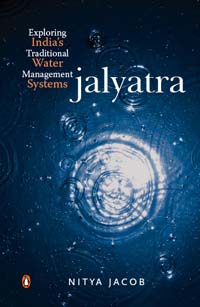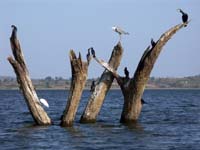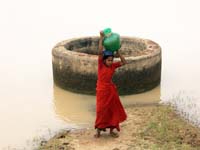 Jalyatra - Exploring India's traditional water management systems, by Nitya Jacob is an ecological travelogue that looks at links between water, society and places It describes in detail what existed, how it fitted into the socio-cultural milieu and was appropriate for the local climate and geography. It then examines reasons for their decline, as indeed most have, in recent decades.
Jalyatra - Exploring India's traditional water management systems, by Nitya Jacob is an ecological travelogue that looks at links between water, society and places It describes in detail what existed, how it fitted into the socio-cultural milieu and was appropriate for the local climate and geography. It then examines reasons for their decline, as indeed most have, in recent decades.
While recording the dismal state of traditional systems, the author stumbles upon small initiatives that have brought about significant transformation across regions. It refers to noisy hidrums and gharaats, the river-run flour mills of Uttaranchal, the technologies whose potential has yet to be fully realised. It looks at water harvesting structures of southern India—the eris and ooranis. However, it admits that the average person is singularly uninterested in protecting the environment.
Jalyatra captures the efforts of NGOs and enlightened individuals striving to revive these systems. It makes the case for a mass movement to revive traditional water management systems, especially village ponds, across the country as the way to ensure water security in India. In Chambal, the author meets Brij Mohan Gujjar, dacoit turned water conservationist, who is doing valuable work on the check dams designed to control the flow of water in the ravines; and in Shillong, Lan Potham shows him the uses of the easily available bamboo to construct the shyngiar which irrigates his areca nut plantation.
Each system, Jacob finds, takes into account the lay of the land, available raw material, as well as the social structure and make-up of the area it serves. Thus the springs of Uttaranchal, important for water supply and social interaction, are also accurate indexes of the caste lines along which the society using them is divided. The upper castes use the water nearest to the source.
The author also notes that in most places, modernization of water supply and management systems, which may range from plastic pipes that have replaced the more malleable bamboo for the shyngiar to inefficient dams, has not succeeded. Jalyatra is important for a more comprehensive understanding of traditional practices in the management of our resources. It also makes the important point that new, improved ways of doing things may not always be the best.
management systems, which may range from plastic pipes that have replaced the more malleable bamboo for the shyngiar to inefficient dams, has not succeeded. Jalyatra is important for a more comprehensive understanding of traditional practices in the management of our resources. It also makes the important point that new, improved ways of doing things may not always be the best.
Water carries different meanings for different people. Our modern demands on this life-saving fluid have constricted its diverse meanings. Water now gets viewed from a quantity-delivery paradigm; how much quantity there is and how much can be supplied? Within this narrow confine, water has been turned into a commodity that can be stored, distributed and traded for profit. With demand outstripping supply, human rights over water have been usurped by vested interests.
 The author laments the unwillingness of people to play a proactive role in demanding accountability from the Government. Not only have people become dependent on the system, they are unwilling to lift a finger in their own interest either. The net result is that between development illiteracy and popular sloth, the politician-bureaucrat-contractor nexus makes hay.
The author laments the unwillingness of people to play a proactive role in demanding accountability from the Government. Not only have people become dependent on the system, they are unwilling to lift a finger in their own interest either. The net result is that between development illiteracy and popular sloth, the politician-bureaucrat-contractor nexus makes hay.
The book is important as India’s traditional water systems – and the principles on which they have been organised – are among the elements that hold greatest promise to provide answers to modern India’s water problems, water needs and water crises.
Contents
The chapters can be downloaded from the Jalyatra website from the links provided below:
Introduction: Desi dawaa for a blue catastrophe
1. Forgotten history lessons: Delhi’s missed date with water
2. Tamil Nadu: Of eris and ooranis
3. Chambal: Watering down dacoits
4. Shillong: Betel nuts and bamboos
5. Shekhawati: ‘Underground’ tanks of the seths
6. Goa: Sun, sand and sea-food are bad for ecology
7. Uttaranchal: Watery spirits
8. Bundelkhand: The hands that built the Khajuraho temples
Conclusion: Little drops do indeed make a mighty ocean
Note: All chapters are not available on the Jalyatra website for download as yet.
/articles/jalyatra-exploring-indias-traditional-water-management-systems